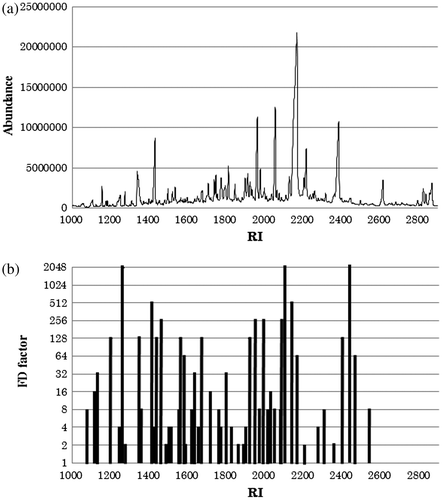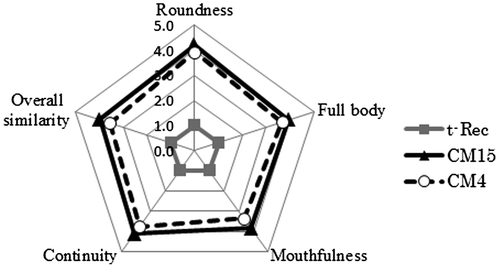Abstract
The aroma extract dilution analysis of an extract prepared from pork stock and subsequent experiments led to the identification of 15 aroma-active compounds in the flavor dilution factor range of 64–2048. Omission experiments to select the most aroma-active compounds from the 15 odor compounds suggested acetol, octanoic acid, δ-decalactone, and decanoic acid as the main active compounds contributing to the aroma of pork stock. Aroma recombination, addition, and omission experiments of these four aroma compounds in taste-reconstituted pork stock showed that each compound had an individual aroma profile. A comparison of the overall aroma between this recombined mixture and pork stock showed strong similarity, suggesting that the key aroma compounds had been successfully identified.
Graphical Abstract
Most aroma-active compounds contributing to the aroma of clear type pork stock detected by AEDA and subsequent omission and addition experiments.
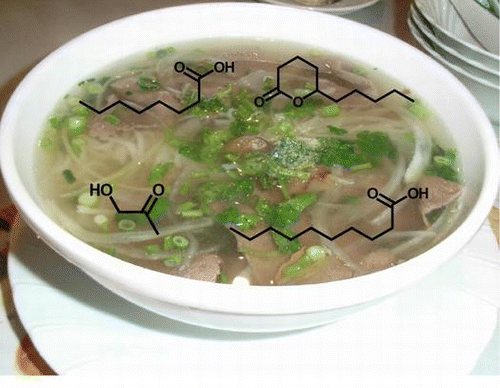
Flavor perception during food intake results from simultaneous activation of the gustatory, olfactory, and trigeminal sensation systems. In particular, olfactory stimulation through the retronasal pathway greatly contributes to the flavor perception of foods.Citation1,2)
The characteristic aroma of meat products significantly contributes to their overall acceptance.Citation3) It has been shown that volatile compounds determine the aroma attributes and are the main contributors to the characteristic aroma of meat.Citation4) However, there is evidence that only a limited number of volatile compounds actually contribute to the overall aroma of food.Citation5)
While the aroma compounds of cooked meat have been widely investigated by using gas chromatography–olfactometry (GC–O),Citation6–12) there has only been limited research on the aroma-active compounds in pork soup stock. Pork soup stock is highly appreciated as a base for savory dishes due to its desirable meaty and fatty flavor profile. There are two types of pork soup stock: the white type (prepared without removing the marrow from the thighbone, followed by boiling at medium to high heat to gradually produce white turbidity), and the clear type (prepared by removing the marrow from the thighbone and boiling at low heat to avoid turbidity). The white type of pork stock has a fatty and animalic flavor profile and is widely used in China and Japan, whereas the clear type of pork stock has a meaty flavor profile and is widely used in South-East Asia.
The aroma compounds from white pork soup stock have already been investigated and ranked according to their aroma intensity and possible contribution to the flavor of the stock.Citation13) However, there has only been limited research on the aroma-active compounds of clear pork stock. It is therefore necessary to conduct aroma recombination studies to validate these early results. The aim of this present study was to identify the most aroma-active compounds in clear pork stock and to examine their contribution to its sensory characteristics.
Materials and methods
Chemicals
All chemicals were purchased from Sigma-Aldrich Japan, Tokyo, Japan.
Preparation of the pork soup stock
Pork thighbone was purchased at a local market, cut in half crosswise, and boiled for 5 min to remove the bone marrow and scum. Pre-cooked pork thighbones (2200 g) were boiled with 13,900 g of tap water for four hours at 93 ± 2 °C with low heat and then strained trough paper towels to obtain clear pork stock. This stock was stored at −21 °C until needed.
Preparation of the volatile fraction of pork soup stock
Pork soup stock (20 mL) was extracted with 20 mL of diethyl ether. The organic layer was combined and dried over anhydrous sodium sulfate. The volatile compounds were isolated by the solvent-assisted flavor evaporation (SAFE) technique,Citation14) with the distillate being concentrated to a final volume of 100 μL under a gentle N2 stream prior to being analyzed.
Gas chromatography–mass spectrometry
The volatile compounds in pork soup stock were analyzed using an Agilent 6890 gas chromatograph and Agilent 5975 mass spectrometer (Agilent Technologies, Japan). A 2-μL aliquot of the extract was injected into a DB-Wax column (10 m length × 0.18 mm i.d., 0.3 μm film thickness; Agilent Technologies, Japan). Helium was used as the carrier gas at a constant linear velocity of 38 cm/s. The oven temperature was programmed to gradually increase from 40 to 240 °C at a rate of 15 °C/min until 220 °C, then at 25 °C/min until 240 °C, with an initial holding time of 1 min and a final holding time of 3 min. The Gas chromatography–mass spectrometry (GC–MS) conditions were as follows: splitless mode; injector temperature, 200 °C; purge on time, 60 s; scan range, 29–350 m/z; and scan rate, 2.2 scans/s.
Aroma extract dilution analysis
ODP2 equipment (Gerstel, Japan) was used for GC–O. A 2-μL aliquot of the pork extract was injected into a DB-WAX column (10 m length × 0.18 mm i.d., 0.3 μm film thickness; Agilent Technologies, Japan). The GC conditions were same as those just described for GC–MS.
The FD factor for a compound is defined as the ratio of its concentration in the initial extract to its concentration in the most dilute extract whose aroma could be detected by GC–O. The FD chromatogram presented here is the average obtained from assessments by three expert panelists.
Identification and quantification of the compounds
Identification of the compounds was based on a comparison of the GC retention indices (RI), mass spectra (Wiley mass spectral database, John Wiley and Sons), and aroma properties of the unknown compounds with those of authentic standard compounds. The identified compounds were quantified by calculating the intensity of the peak area of each compound relative to the intensity of the respective diethyl ether standard solution.
Sensory comparison of a recombined aroma mixture with the pork stock
The evaluation panel comprised three expert assessors who were trained to describe and recognize the aroma qualities of pork soup stock. The five flavor descriptors (shown in parentheses) that contributed to the characteristic flavor of pork soup stock were selected by comparing the pork soup stock with taste-reconstituted pork stock (t-Rec; Table ): roundness (light fatty or oily flavor), full body (strong fatty flavor), mouthfulness (rich boiled meat-like and complicated flavor), continuity (long-lasting boiled meat-like flavor), and overall similarity to pork stock.
Table 1. Composition of taste-reconstituted pork stock (t-Rec).
The t-Rec samples were prepared on the basis of an analysis of the basic taste compounds (amino acids, ATP metabolites, and inorganic ions) of pork stock, according to the analysis method of Fujimura et al.Citation15) (Table ). A complete mixture of 15 aroma compounds (CM15) and a complete mixture of the four most aroma-active compounds (CM4) were, respectively, prepared by adding all 15 aroma compounds with an FD value of ≥64 and the four most aroma-active compounds to t-Rec, according to the concentration from a quantitative analysis of the pork stock. CM15 and CM4 were presented to the sensory panel for comparison with pork stock and t-Rec.
The evaluation was performed by presenting each solution (20 mL) to the panelists in small (50 mL) cups, and they were asked to rate the intensity of the five flavor qualities when compared with t-Rec and pork soup stock. The intensity was rated by using a scale of 1.0 (not perceivable = t-Rec), 2.0 (weak), 3.0 (medium), 4.0 (strong), and 5.0 (very strong = pork soup stock). The results obtained were averaged for each flavor characteristic and plotted on a spider web diagram.
Selection of the most aroma-active compounds by using omission experiments
A sensory evaluation was conducted in the same way as that just described.
Based on the concentrations obtained in the quantitative analysis of the pork soup stock, 15 model mixtures were prepared by individually omitting the following aroma compounds from CM15: acetol (OM1-1), nonanal (OM1-2), acetic acid (OM1-3), benzaldehyde (OM1-4), 1-octanol (OM1-5), 3-methylbutanoic acid (OM1-6), 2-pentadecanone (OM1-7), octanoic acid (OM1-8), nonanoic acid (OM1-9), δ-decalactone (OM1-10), methyl palmitate (OM1-11), decanoic acid (OM1-12), dodecanoic acid (OM1-13), 5-(hydroxymethyl) furfural (OM1-14), and vanillin (OM1-15). Each model mixture was presented to the sensory panel for a comparison with CM15.
The evaluation was performed by presenting each solution (20 mL) to the panelists in small (50 mL) cups, and they were requested to rate the overall similarity to CM15 on a scale of 1.0 (different), 2.0 (little similarity), 3.0 (similar), 4.0 (almost the same), and 5.0 (same). The results were then averaged and plotted on a bar graph.
Sensory profiling by addition experiments
A sensory evaluation was conducted in the same way as that already described.
Four model mixtures were prepared by individually adding the following aroma compounds to t-Rec, according to the concentration obtained by a quantitative analysis of the pork stock: acetol (AD1), octanoic acid (AD2), δ-decalactone (AD3), and decanoic acid (AD4). Each model mixture was presented to the sensory panel for comparison with t-Rec.
The evaluation was performed in the same way as that already described.
Sensory profiling by using omission experiments
A sensory evaluation was conducted in the same way as that already described.
Four model mixtures were prepared by omitting the following odorants from CM4: acetol (OM2-1), octanoic acid (OM2-2), δ-decalactone (OM2-3), and decanoic acid (OM2-4). Each model mixture was presented to the sensory panel for comparison with CM4.
The evaluation was performed in the same way as that already described.
Results and discussion
Identification of the aroma-active compounds
To evaluate whether the overall aroma could be isolated by SAFE distillation, one small drop of the distillate was evaluated on a blotter card. The aroma of the extract immediately evoked the characteristic aroma of pork soup stock, thereby confirming that the key aroma compounds had been exhaustively extracted by distillation. After isolating the aroma compounds in the pork soup stock, the aroma-active compounds in the extracts were located by means of Aroma extract dilution analysis (AEDA).
Fifteen compounds were identified in pork stock with an FD factor of ≥64 (Table ). The chromatogram (Fig. ) clearly indicates that the major volatiles showing high signals were not all aroma-active compounds. These 15 compounds were identified and quantified as acetol, nonanal, acetic acid, benzaldehyde, 1-octanol, 3-methylbutanoic acid, 2-pentadecanone, octanoic acid, nonanoic acid, δ-decalactone, methyl palmitate, decanoic acid, dodecanoic acid, 5-(hydroxymethyl) furfural, and vanillin.
Table 2. Aroma-active compounds (FD ≥ 64) identified in the pork stock.
Comparison of the recombined aroma mixture with pork soup stock
To confirm the sensory impact of the identified aroma compounds on the flavor of pork soup stock, the sensory panel compared a complete mixture of 15 aroma compounds (CM15) with an FD factor of ≥64 with t-Rec and pork soup stock. Compared with t-Rec, the sensory scores for all the flavor descriptors, particularly roundness (1.0–4.2) and continuity (1.0–4.1), markedly increased and almost reached an intensity of 5.0 which was that for pork soup stock (Fig. ). These data indicate that the key aromatic compounds in the clear pork stock had been successfully identified.
Selection of the most aroma-active compounds by using omission experiments
Omission experiments were performed to select the most aroma-active compounds from the 15 aromatic compounds. Fig. shows that the overall similarity for OM1-1 (2.8; p < 0.001), OM1-8 (2.6; p < 0.001), OM1-10 (3.0; p < 0.001), and OM1-12 (2.4; p < 0.001) was lower than the intensity for CM15 (4.0). This demonstrates that acetol, octanoic acid, δ-decalactone, and decanoic acid individually contributed to the quality of pork stock.
Fig. 3. Comparative overall similarity analysis of the complete mixture (CM15) consisting of 15 aroma compounds dissolved in t-Rec and OM1-1 (acetol omission), OM1-2 (nonanal omission), OM1-3 (acetic acid omission), OM1-4 (benzaldehyde omission), OM1-5 (1-octanol omission), OM1-6 (3-pethylbutanoic acid omission), OM1-7 (2-pentadecanone omission), OM1-8 (octanoic acid omission), OM1-9 (nonanoic acid omission), OM1-10 (δ-decalactone omission), OM1-11 (methyl palmitate omission), OM1-12 (decanoic acid omission), OM1-13 (dodecanoic acid omission), OM1-14 (5-(hydroxymethyl) furfural omission), and OM1-15 (vanillin omission).
Note: *p < 0.001 is considered statistically significant.
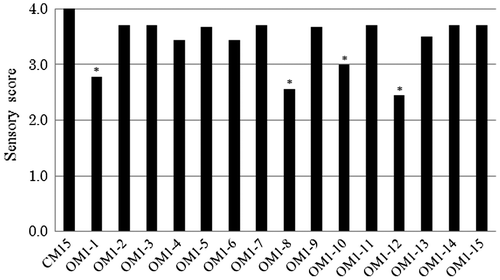
To confirm the sensory impact of these four aroma compounds on the flavor of pork stock, the sensory panel was then asked to evaluate the flavor profile of CM4 in comparison with CM15 and t-Rec. The overall similarity of CM4 was 3.6 (CM15: 4.0), and the intensity of all flavor descriptors reached the intensity of CM15 (Fig. ). These data show that the most aroma-active compounds in pork stock, acetol, octanoic acid, δ-decalactone, and decanoic acid, had been successfully isolated and identified.
Sensory profiling of the identified compounds
Addition experiments were performed to study the sensory profile of the individual identified compounds. The intensities of several flavor descriptors of AD1–AD4 were found to be higher than those in t-Rec (Fig. ). The intensities of mouthfulness (1.6) and continuity (1.5) of AD1 were significantly higher than those of t-Rec (p < 0.001). This indicates that acetol contributed to the mouthfulness and continuity flavor profiles in pork stock. Similarly, the intensities of roundness (1.7) and mouthfulness (1.7) of AD2 were higher than those of t-Rec (p < 0.001), indicating that octanoic acid contributed to the roundness and mouthfulness flavor profiles in pork stock. In addition, the intensity of roundness (1.8) for AD3 was higher than that for t-Rec (p < 0.001), indicating that δ-decalactone contributed to the roundness flavor profile in pork stock, whereas the intensity of full body (1.8) for AD4 was higher than that for t-Rec (p < 0.001), indicating that decanoic acid contributed to the full body flavor profile in pork stock. Finally, omission experiments were performed to study the sensory profile of the individual compounds. Fig. shows that the intensities of several flavor descriptors of OM2-1 to OM2-4 were lower than those in CM4. The intensities of mouthfulness (2.5) and continuity (2.5) for OM2-1 were significantly lower (p < 0.001) than those for CM4 (3.4 and 3.8, respectively). This indicates that acetol contributed to the mouthfulness and continuity flavor profiles in pork stock. Similarly, the intensities of roundness (2.5) and mouthfulness (2.4) for OM2-2 were significantly lower (p < 0.001) than those for CM4 (3.9 and 3.4, respectively). This indicates that octanoic acid contributed to the roundness and mouthfulness flavor profiles in pork stock. The intensity of the roundness (2.4) for OM2-3 was lower than that for CM4 (3.9; p < 0.001), indicating that δ-decalactone contributed to the roundness flavor profile in pork stock, whereas the intensities of full body (2.3) and mouthfulness (2.3) for OM2-4 were lower than those for CM4 (3.7 and 3.4, respectively; p < 0.001), indicating that decanoic acid contributed to the full body and mouthfulness flavor profiles in pork stock.
Fig. 5. Comparative flavor profile analysis of a complete mixture (CM4; dashed) consisting of four aroma compounds dissolved in t-Rec and of (A) AD1 (black; acetol addition), (B) AD2 (black; octanoic acid addition), (C) AD3 (black; δ-decalactone addition), and (D) AD4 (black; decanoic acid addition).
Note: *p < 0.001 is considered statistically significant.
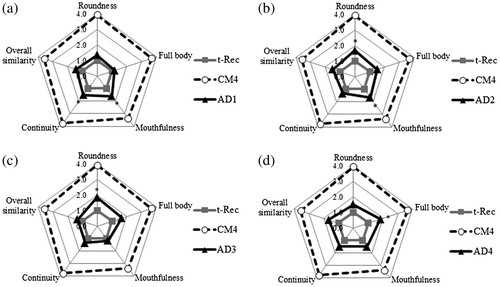
Fig. 6. Comparative flavor profile analysis of a complete mixture (CM4; dot) consisting of four aroma compounds dissolved in t-Rec and of (A) OM2-1 (black; acetol omission), (B) OM2-2 (black; octanoic acid omission), (C) OM2-3 (black; δ-decalactone omission), and (D) OM2-4 (black; decanoic acid omission).
Note: *p < 0.001 is considered statistically significant.
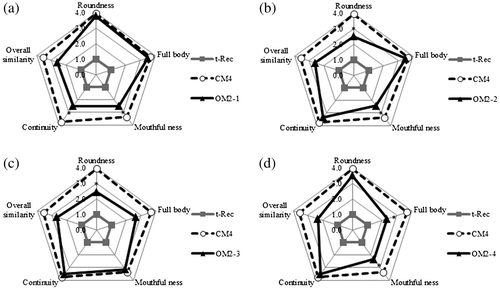
Based on the data obtained from the addition and omission experiments, we concluded that acetol, octanoic acid, and decanoic acid contributed to the mouthfulness, boiled meat-like rich and complicated flavor. Acetol also had a flavor profile of continuity, with a long-lasting boiled meat flavor, whereas octanoic acid had roundness, fatty, or oily light flavor. Decanoic acid had a full body, fatty strong flavor profile, in addition to a mouthfulness flavor, whereas δ-decalactone had a specialized flavor profile of roundness and fatty or oily light flavor. These compounds were therefore important contributors to each characteristic flavor of pork soup stock.
The aromatic compounds in the white pork stock have already been investigated and have been ranked according to their aroma intensity and possible contribution to pork stock flavor. It is known that hexanal, (E,E)-2,4-nonadienal, 2-undecenal, 1-octen-3-ol, and 1-octanol were critical aromatic compounds in the white pork stock.Citation13)
It is also known that bone marrow is largely composed of lipids.Citation16) Furthermore, a higher amount of lipids has produced more compounds formed by lipid oxidation in the meat broth from chickens and cows.Citation17) Those critical compounds in the white pork stock may be produced primarily by lipid oxidation during the preparation of the white pork stock. Since the white pork stock contained a large amount of lipids from the marrow and was boiled at boiling point (around 100 °C) with medium to high heat, it resulted in considerable white turbidity. However, those compounds in the white pork stock were not identified as the key aroma compounds in the clear pork stock. Lipid oxidation may not be the main reaction when preparing the clear pork stock, because it did not contain the marrow and was heated at 93 ± 2 °C with low heat, thereby avoiding the production of white turbidity. This is the first study to confirm the key aromatic compounds in the clear pork stock by using aroma recombination, addition, and omission experiments to study the roles of each compound. However, further studies are necessary to confirm the generation pathway and differences in the key aroma compounds between the white and clear pork stock.
Notes
Abbreviations: AEDA, aroma extract dilution analysis; FD, flavor dilution; GC, gas chromatography; GC–MS, gas chromatography–mass spectrometry; GC–O, gas chromatography–olfactometry; MS, mass spectrum; RI, retention index; SAFE, solvent-assisted flavor evaporation.
References
- Shepherd GM. Smell images and the flavour system in the human brain. Nature. 2006;444:316–321.
- Verhagen JV, Engelen L. The neurocognitive bases of human multimodal food perception: sensory integration. Neurosci. Biobehav. Rev. 2006;30:613–650.
- Shahidi F. Flavor of meat and meat products-an overview. In: Shahidi F, editor. Flavor of meat and meat products. Cornwall: Chapman and Hall; 1994. p. 1–3.
- Mottram DS. Flavour formation in meat and meat products: a review. Food Chem. 1998;62:415–424.
- Schieberle P. New developments in methods for analysis of volatile flavor compounds and their precursors. In: Gaonkar AG, editor. Characterization of food: emerging methods. Amsterdam: Elsevier Science; 1995. p. 403–431.
- Farmer LJ, Patterson RLS. Compounds contributing to meat flavour. Food Chem. 1991;40:201–205.
- Kerscher R, Grosch W. Comparative evaluation of potent odorants of boiled beef by aroma extract dilution and concentration analysis. Z. Lebensm. Unters. Forsch. 1997;204:3–6.
- Kerscher R, Grosch W. Comparison of the aromas of cooked beef, pork, and chicken. In: Schieberle P, Engel K-H, editors. Frontiers of the flavour science. Freising: Deutsche Forschungsanstalt für Lebensmittelchemie; 2000. p. 17–20.
- Söllner K, Schieberle P. Decoding the key aroma compounds of a Hungarian-type salami by molecular sensory science approaches. J. Agric. Food Chem. 2009;57:4319–4327.
- Christlbauer M, Schieberle P. Characterization of the key aroma compounds in beef and pork vegetable gravies a la chef by application of the aroma extract dilution analysis. J. Agric. Food Chem. 2009;57:9114–9122.
- Carrapiso AI, Jurado Á, Timón ML, García C. Odor-active compounds of Iberian hams with different aroma characteristics. J. Agric. Food Chem. 2002;50:6453–6458.
- Carrapiso AI, Ventanas J, García C. Characterization of the most odor-active compounds of Iberian ham headspace. J. Agric. Food Chem. 2002;50:1996–2000.
- Xu Y, Chen Q, Wu P, Xu X, Wang K, Pan S. Characterization of aroma components in stewed pork broth by GC-O. Shipin Kexue. 2011;32:274–277.
- Engel W, Bahr W, Schieberle P. Solvent assisted flavour evaporation -a new and versatile technique for the careful and direct isolation of aroma compounds from complex food matrixes. Eur. Food Res. Technol. 1999;209:237–241.
- Fujimura S, Kawano S, Koga H, Takeda H, Kadowaki M, Ishibashi T. Identification of Taste-Active Components in the Chicken Meat Extract by Omission Test – Improvement of Glutamic Acid, IMP and Potassium Ion. Anim. Sci. Technol. 1995;66:43–51. Japanese.
- Moerck KE, Ball HR Jr. Lipids and fatty acids of chicken bone marrow. J. Food Sci. 1974;38:978–980.
- Gasser U, Grosch W. Primary odorants of chicken broth. Z. Lebensm. Unters. Forsch. 1990;190:3–8.

